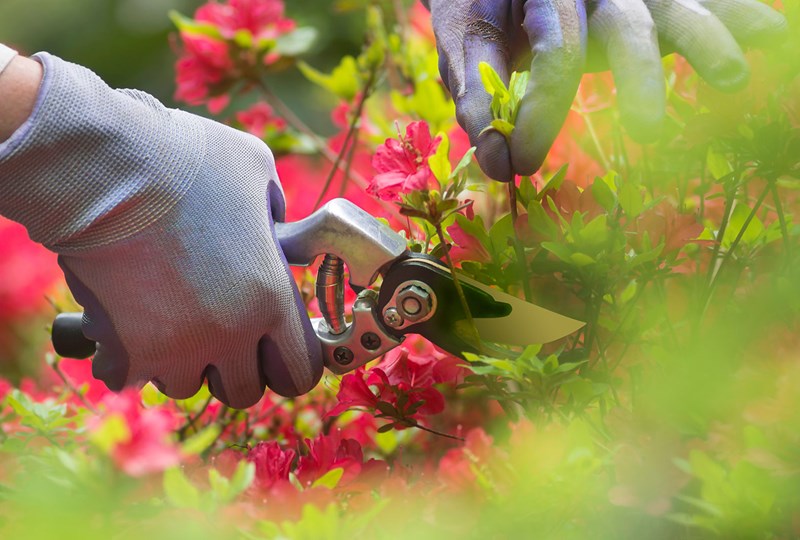
<blockquote?
Key insights:
- Certain perennials should be cut back in the fall to help them flourish next year, while others can be left alone.
- Check your plants for any signs of diseases, like rotting leaves, discoloration and wilting blooms. Diagnose the issue for treatment and dispose of the diseased sections appropriately.
- Help protect your plants against harsh weather by adding a layer of mulch for insulation.
Perennial flowers and plants can add easy beauty and blossoms to your lawn. To keep these plants healthy for years to come, it may be necessary to cut your perennials in the fall; this will help ensure the most robust blooms come spring.
Although you may associate the season of fall with raking leaves rather than tending to the garden, now is the perfect time to give your landscaping a little extra care. You may find you have more time in the fall than in the spring when you’ll be busy planting annual flowers and rejuvenating your yellowed, post-winter lawn.
Here are tips to help you take advantage of the last bit of nice weather as you prep your garden for spring.
Cut back these perennials in the fall
When left out for winter without proper care, perennials are at risk of decay and disease. However, cleaning and pruning your garden will set up your plants for a successful and healthy bloom in the spring.
To keep your garden in optimal condition, a Master Gardener recommends cutting back these plants in the fall:
- Plants prone to fungus
- Bee balm
- Flowering bulbs
- Geranium
- Mint
- Bleeding hearts
- Phlox
- Hosta
- Leafy plants with little or no flower heads
Of course, different plants require different treatments. Here’s how to cut back three of the most common Midwestern perennial plants by the time the winter frost hits.
Peony: Because peonies are susceptible to foliage diseases and blossom blights, it’s smart to prune the tops of the plants back to near soil level. You’ll decrease your risk of diseased plants by removing these leaves and stems; then you will be greeted by lovely spring flowers.
Daylily: The leaves of the daylily can’t withstand the winter cold. Be sure to cut back daylily foliage after a light frost. This will save you the mess of clearing mushy leaves when spring rolls around. Plus, removing old leaves provides room for new, fresh growth of the plant.
Hosta: Around the first frost, cut hosta leaves down one to two inches above soil level. Not only is this good for the plant, but it will be easier for you as well. If you wait to remove hosta foliage until after winter, the leaves will become mushy and difficult to prune.
Plants to leave “as is” through the winter
After you’ve taken care of your perennials that need pruning, the following perennials can be left for the winter:
- Blue False Indigo
- Coneflower
- Black-eyed Susan
- Sedum
- Native grass and ornamental grass
- Hydrangea
These plants are hardy. They can withstand the winter, then blossom again in the spring.
Do you have diseased plants?
Strange spots, discoloration, wilting flowers and rotting leaves are all signs that you could have a diseased plant in your garden. By pruning back your garden in the fall, you can help prevent further damage and hopefully revive your plants for a healthy spring.
But after you cut down your plants, what should you do with the diseased plant matter? According to the University of Minnesota, it’s recommended that you determine what the disease is using an online diagnostic tool or by submitting a sample and then disposing of it safely according to your local regulations. You will also want to clean all your garden tools thoroughly.
Protect your plants for the winter!
The final step to keep your plants safe from winter snow is to cover your perennials. To do this, add a layer of mulch (think shredded leaves, straw or bark) on top of your perennials. This layer should be about four to eight inches thick to protect and insulate your garden’s roots from the bitter cold that winter brings.
Whether you’re preparing your garden to survive winter or getting your landscaping in pristine condition for a move, we’re here to help. For more homeowner tips or help coordinating your next move, reach out to Edina Realty or one of our agents.
Source: Advice was contributed in 2019 by Master Gardener (and now retired Edina Realty employee) Patti Lauer. Some links and information have since been updated.









 ©2025 Prosperity Home Mortgage LLC®. (877) 275-1762. 3060 Williams Drive, Suite 600, Fairfax, VA 22031. All first mortgage products are provided by Prosperity Home Mortgage, LLC®. Not all mortgage products may be available in all areas. Not all borrowers will qualify. NMLS ID #75164 (For licensing information go to: NMLS Consumer Access at
©2025 Prosperity Home Mortgage LLC®. (877) 275-1762. 3060 Williams Drive, Suite 600, Fairfax, VA 22031. All first mortgage products are provided by Prosperity Home Mortgage, LLC®. Not all mortgage products may be available in all areas. Not all borrowers will qualify. NMLS ID #75164 (For licensing information go to: NMLS Consumer Access at